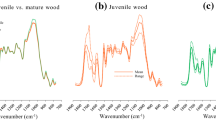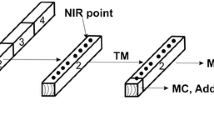Abstract
-
• Dimensional stability, along with the natural durability and colour of the wood, is one of the most important characteristics of teak used as timber. However, it is very time-consuming to take measurements of this kind. For the purposes of selection for the production of improved varieties, the number of samples to be measured rapidly exceeds the capacity of a traditional laboratory.
-
• Near-infrared spectroscopy, based on a set of reference data, is a tool enabling many of the chemical properties of wood to be predicted and the number of laboratory measurements to be reduced exponentially. The issue here is a question of checking the effectiveness of NIRS tool to build models and predict the shrinkage and fibre saturation point of teak wood from Togo.
-
• The results show the possible use of NIRS to measure the dimensional stability of teak wood and that it is appropriate to choose the type of wood and type of surface to be measured by NIRS. The best prediction models for radial and tangential shrinkage and fibre saturation point give R 2 values of 0.72, 0.83 and 0.87 respectively with ratios of performance deviation of 1.8, 2.4 and 2.8.
-
• Consequently, after verification on other sets of teak samples, which may or may not be included in the prediction model, NIRS can be used to predict shrinkage and fibre saturation point values accurately for a large number of samples, making it possible to include these characteristics in the selection criteria for classifying wood and high throughput phenotyping.
Résumé
-
• La stabilité dimensionnelle avec la durabilité naturelle et la couleur du bois, est l’une des plus importantes caractéristiques pour le teck utilisé en bois d’œuvre. Néanmoins, les mesures de ce caractère sont longues et coûteuses en temps. Pour les besoins de la sélection pour la production de variétés améliorées, le nombre d’échantillons à mesurer devient vite supérieur aux capacités d’un laboratoire traditionnel.
-
• La spectroscopie proche infrarouge, sur la base d’un jeu de données de références, est un outil qui permet de prédire de nombreuses propriétés chimiques du bois et de réduire le nombre de mesures de laboratoire de façon exponentielle. La question ici est de vérifier l’efficacité de l’outil NIRS pour construire des modèles et prédire les retraits et le point de saturation des fibres du bois de teck provenant de plantations du Togo.
-
• Les résultats démontrent la possible utilisation de la SPIR pour mesurer la stabilité dimensionnelle du bois de teck et qu’il a y lieu de choisir le type de bois et le type de face que l’on mesure par SPIR. Les modèles de prédiction pour les retraits radial et tangentiel et le point de saturation des fibres montrent des R2 de 0,72, 0,83, 0,87 respectivement avec des rapports d’efficacité de 1,8, 2,4 et 2,8.
-
• En conséquence, et après vérification sur d’autres jeux d’échantillons de teck, qu’il conviendra ou non d’intégrer dans le modèle de prédiction, la SPIR permet de prédire des valeurs de retrait et de PSF avec efficacité pour un grand nombre d’échantillons rendant possible l’intégration de ces caractères dans les critères de sélection pour le classement des bois et pour le phénotypage à grande échelle.
Similar content being viewed by others
References
Alves A., Schwanninger M., Pereira H., and Rodrigues J., 2006. Calibration of NIR to assess lignin composition (H/G ratio) in maritime pine wood using analytical pyrolysis as the reference method, Holzforschung 60: 29–31.
Arevalo Fuentes R.L., 2002. Influence des composantes secondaires et de la structure anatomique sur les propriétés physico-mécaniques du bois d’Acajou (Swietenia macrophylla King). Ph.D., Département des sciences du bois et de la forêt/ Faculté de foresterie et de géomatique, Université Laval, Québec, 145 p.
Baillères H. and Durand P., 2000. Non-destructive techniques for wood quality assessment of plantation-grown teak. Bois et Forêts des Tropiques 263: 17–29.
Baillères H., Davrieux F., and Ham-Pichavant F., 2002. Near infrared analysis as a tool for rapid screening of some major wood characteristics in a eucalyptus breeding programme. Ann. For. Sci. 59: 479–490.
Berry L.S. and Roderick L.M., 2005. Plant-water relations and the fibre saturation point. New Phytol. 168: 25–37.
Bhat K.M., 1998. Properties of fast-grown teakwood: impact on endusers’ requirements. J. Trop. For. Prod. 4: 1–10.
Bhat K.M. and Priya P.B., 2004. Influence of provenance variation on wood properties of teak from the western Ghat region in India. IAWA J. 25: 273–282.
Boeriu G.C., Bravo D., Gosselink R.J.A., and Van Dam J.E.G., 2004. Characterisation of structure-dependent functional properties of lignin with infrared spectroscopy. Ind. Crops Prod. 20: 205–218.
Brémaud I., 2006. Diversité des bois utilisés ou utilisables en facture d’instruments de musique. Ph.D. thesis in Mechanics, Univ. Montpellier II, 294 p.
Brinkmann K., Blaschke L., and Polle A., 2002. Comparison of different methods for lignin determination as a basis for calibration of near-infrared reflectance spectroscopy and implications of lignoproteins. J. Chem. Ecol. 28: 2483–2500.
Chafe C., 1987. Collapse, volumetric shrinkage, specific gravity and extractives in Eucalyptus and others species. Part II: The influence of wood extractives. Wood Sci. Technol. 21: 27–41.
Cogdill R.P., Schimleck L.R., Jones P.D., Peter G.F., Daniels R.F., and Clark A., 2004. Estimation of the physical wood properties of Pinus taeda L. Radial strips using least squares support vector machines. J. Near Infrared Spec. 12: 263–269.
Edwin L. and Ashraf M.P., 2006. Assessment of biodeterioration of rubber wood exposed to field conditions. Int. Biodeter. Biodegr. 57: 31–36.
Ern H., 1979. Die Vegetation Togo. Gliederrung, Gefährdung, Erhaltung. Willdenowia. 9: 295–312.
Guitard D., 1987. Mécanique du matériau bois et composites. Cépaduès, 238 p.
Gierlinger N., Jacques D., Schwanninger M., Wimmer R., Hinterstoisser B., and Paques L.E., 2003. Rapid predictions of natural durability of larch heartwood using Fourier transform near-infrared spectroscopy. Can. J. For. Res. 33: 1727–1736.
Haluk J.P., Roussel C., and Thévénon M.F., 2001. Importance des quinones dans les propriétés antifongiques du Teck (Tectona grandis). Les cahiers Scientifiques du Bois 2: 77–83.
Hedrick E.S., Bennett M.R., Asce M., Rials T.G., and Kelley S.S., 2007. Correlation of near-infrared spectroscopy measurements with the properties of treated wood. J. Mater. Civil Eng. 19: 279–285.
Hein G.P.R., Lima J.L., and Chaix G., 2009. Robustness of models based on near infrared spectra to predict the basic density in Eucalyptus urophylla wood. J. Near Infrared Spec. 17: 141–150.
Hernandez R.E., 2007. Effects of extraneous substances, wood density and interlocked grain on fiber saturation point of hardwoods. Wood Mat. Sci. Eng. 2: 45–53.
Kelley S.S., Rials T.G., Snell R., Groom L.H., and Sluiter A.D., 2004. Use of near-infrared spectroscopy to measure the chemical and mechanical properties of solid wood. Wood Sci. Technol. 38: 257–276.
Kokutse A.D., Baillères H., Stokes A., and Kokou K., 2004. Proportion and quality of heartwood in Togolese teak (Tectona grandis L.f). For. Ecol. Manage. 189: 37–48.
Monrroy M., Mendonça R., Baeza J., Ruiz J., Ferraz A., and Freer J., 2008. Estimation of hexenuronic acids and kappa number in kraft pulps of Eucalyptus globulus by Fourier transform near infrared spectroscopy and multivariate analysis. J. Near Infrared Spec. 16: 121–128.
Pahup S., Sunita J., and Sangeeta B., 1989. A 1, 4-Anthraquinone derivate from Tectona grandis. Phytochemistry 28: 1258–1259.
Raymond C.A., Schimleck L.R., Muneri A., and Michell A.J., 2001. Nondestructive sampling of Eucalyptus globulus and E. nitens for wood properties. III. Predicted pulp yield using near infrared reflectance analysis. Wood Sci. Technol. 35: 203–215.
Ruelle J., Beauchene J., Thibaut A., and Thibaut B., 2007. Comparison of physical and mechanical properties of tension and opposite wood from ten tropical rainforest trees from different species. Ann. For. Sci. 64: 503–510.
Sanwo S.K., 1987. The characteristics of the crown-formed and stem-formed wood in plantation Grown teak (Tectona grandis L.f) in Nigeria. J. Inst. Wood Sci. 11: 85–88.
Schimleck L.R., Wright P.J., Michell A.J., and Wallis A.F.A., 1997. Near-infrared spectra and chemical composition of Eucalyptus globulus and E. nitens plantation woods. Appita J. 50: 40–45.
Schimleck L.R. and Michell A.J., 1998. Determination of within-tree variation of Kraft pulp yield using near-infrared spectroscopy. Appita J. 81: 229–236.
Schimleck L.R., Stürzenbecher R., Mora C., Jones P.D., and Daniels R.F., 2005. Comparison of Pinus taeda L. wood property calibrations based on NIR spectra from the radial-longitudinal and radial-transverse faces of wooden strips. Holzforschung 59: 214–218.
Schimleck L.R., Sussenbach E., Leaf G., Jones P.D., and Huang C.L., 2007. Microfibril angle prediction of Pinus taeda wood samples based on tangential face NIR spectra. IAWA J. 28: 1–12.
Simatupang H.M. and Yamamoto K., 2000. Properties of teakwood (Tectona grandis L.f) and Mahogany (Swietenia macrophylla King) from manmade forest and influence on utilization. In: Hing Hon C., Matsumoto K. (Eds.). Proceeding of seminar on high value timber for plantation establishment. Conference Tawau, Sabah, Japan. JIRCAS. Report N∘ 16, pp. 103–114.
Simpson W. and Ten Wold A., 1999. Physical properties and moisture relations of wood. In: Wood handbook — Wood as an engineering material, US Department of Agriculture, Forest Service, Forest Products Laboratory, 463 p.
Stamm A.J., 1971. Review of nine methods for determining the fiber saturation points of wood and wood products. Wood Sci. 4: 114–128.
Taylor A.M., Baek S.H., Jeong M.K. and Nix G., 2008. Wood shrinkage prediction using NIR spectroscopy. Wood Fiber Sci. 40: 301–307.
Trokenbrodt M. and Josue J., 1999. Wood properties and utilisation potential of plantation teak (Tectona grandis) in Malaysia: a critical review. J. Trop. For. Prod. 5: 58–70.
Tsuchikawa S., 2007. A review of recent near infrared research for wood and paper. Appl. Spectrosc. Rev. 42: 43–71.
Williams P.C. and Sobering D.C., 1993. Comparison of commercial near infrared transmittance and reflectance instruments for analysis of whole grains and seeds. J. Near Infrared Spectrosc. 1: 25–33.
Wright J.A., Birkett M.D., and Gambino M.J.T., 1990. Prediction of pulp yield and cellulose content from wood samples using near infrared reflectance spectroscopy. Tappi J. 73: 164–166.
Yamamoto K., Simatupang H.M., and Hashim R., 1998. Caoutchouc in teak wood (Tectona grandis L.f.): formation, location, influence on sunlight irradiation, hydrophobicity and decay resistance. Holz Roh Werkst. 56: 201–209.
Author information
Authors and Affiliations
Corresponding author
Rights and permissions
About this article
Cite this article
Kokutse, AD., Brancheriau, L. & Chaix, G. Rapid prediction of shrinkage and fibre saturation point on teak (Tectona grandis) wood based on near-infrared spectroscopy. Ann. For. Sci. 67, 403 (2010). https://doi.org/10.1051/forest/2009123
Received:
Accepted:
Issue Date:
DOI: https://doi.org/10.1051/forest/2009123




